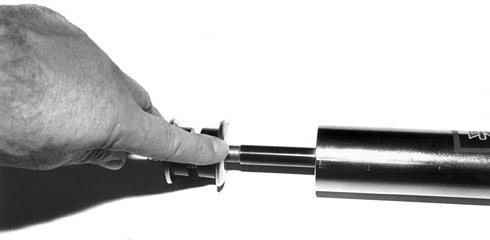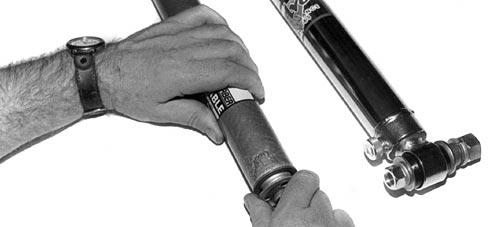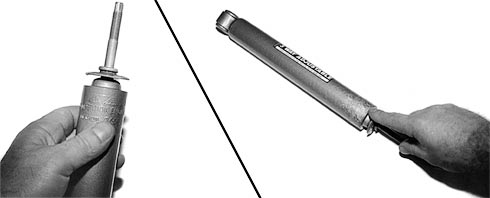

One thing you'll notice
on both types of shocks (vintage Hal Corp and
Competition Engineering) is the lack of dust
covers or shields. These are race shocks and
because of that, there's no need for the extra
hardware.
C-E shocks are adjusted by turning the upper
collar on the body. Adjust the shock by aligning
the notch on the collar with the adjustment
setting range on the shock. Each front shock
has an adjustment range of 10/90, 20/80 and
40/60. The first number (as an example, the
"10" in a 10/90 combo) corresponds to the percentage
of energy required to extend the shock (rebound)
while the second number refers to the energy
required to compress (bump) the shock. In drag
racing terms, that's the same as a 90/10, 80/20
and 60/40.

The C-E shocks are adjusted
by turning the upper collar. You adjust the
shock by aligning the notch on the collar with
the adjustment setting range on the shock. Each
front shock has an adjustment range of 10/90,
20/80 and 40/60. In drag racing terms, that's
the same as a 90/10, 80/20 and 60/40.
The C-E shock must be removed from the car
to set the valving. Here's the drill: Before
you make any attempt to set the valving, hold
the shock upright and run it through it's travel
ten or twelve times (this might take some serious
muscle power initially). This purging effectively
removes any aeration inside the shock. If you
"stroke" the shock upside down or sideways,
air is allowed into the shock and you won't
get the adjustment right. Next, the shock is
fully depressed (remember to maintain the upright
orientation) and you have to line up the notch
on the collar with the setting range on the
shock body. With the shock still depressed,
the adjustment collar is rotated clockwise until
a click is heard. This means that the internal
adjustment mechanism is now engaged. Basically,
you have to rotate the notch on the indicator
until it reaches the desired setting ("XF",
"F" or "R"). You can now reinstall the shock.

These are the stamped
setting codes on the body of the C-E shock:
"XF", "F" and "R". The break down is as follows:
"XF" = 40/60; "F" = 20/80; "R" = 10/90. If the
shock is set at "R" or 10/90, then it only needs
10 percent of the total force to extend it.
To compress the shock, 90 percent of the force
is used.

|